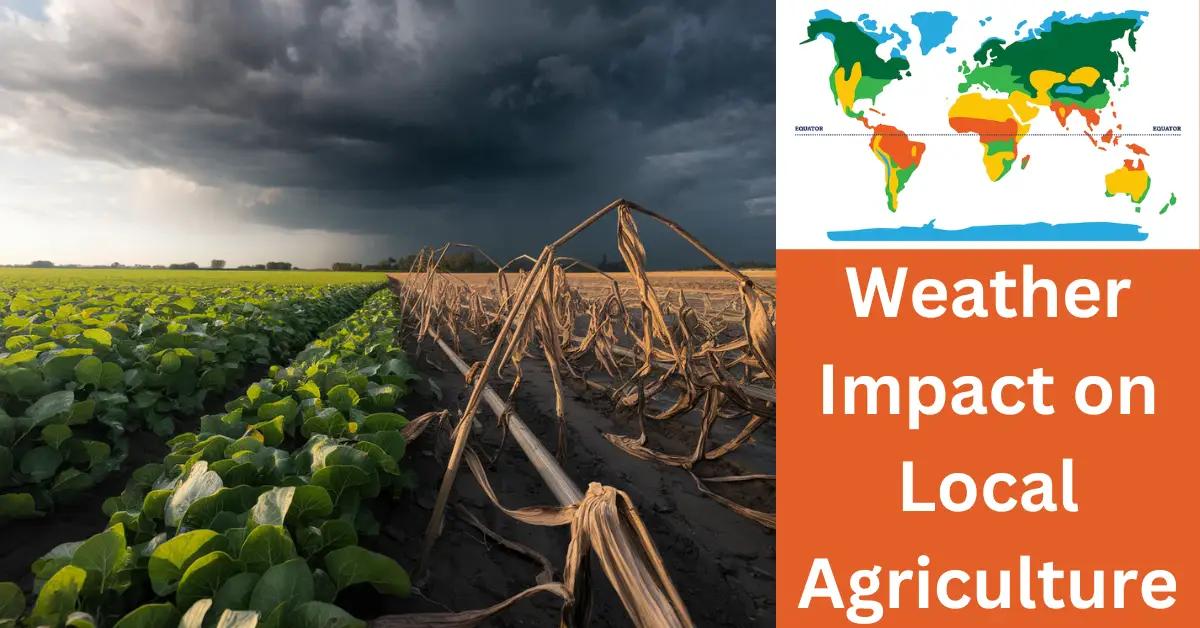TL;DR:
- Weather affects agriculture via temperature fluctuations, extreme events (droughts, floods), and seasonal changes, impacting productivity.
- Climate change shifts temperatures, increasing crop stress, pests, and necessitating new resilient agricultural practices like crop rotation and mulching.
- Environmental factors affecting farming include soil health, water availability, biodiversity, sustainable soil management, and renewable energy usage.
- Weather forecasting boosts agricultural planning, helping with planting, harvesting, pest management, and enhancing resilience.
- Climate variability impacts crop yield, causing income uncertainty; diversification and genetic modifications are crucial for adaptation.
- Innovative farming techniques for climate adaptation include hydroponics, carbon sequestration, regenerative agriculture, and agroforestry, enhancing sustainability and resilience.
Weather can make or break a farm's success. Temperatures, rain, and storms hit hard. Ever wonder why some crops flourish while others falter? Let's explore how weather swings influence crop yields and farming productivity. Discover how farmers adapt to these challenges and why understanding weather is crucial. You’ll learn how climate impacts farming and ways you can prepare for unpredictable conditions in your new home country.
Weather Influence on Farming: How Does Weather Affect Agriculture?
How does the weather affect agriculture? Weather can change farming in many ways. Temperature changes are a big factor. For instance, if it's too cold or too hot, crops may not grow well. This means less food can be produced. Little plants can freeze or wilt, and that hurts us all.
Another concern is extreme weather events. Droughts dry out the soil, making it too hard to plant seeds or grow healthy plants. Floods, on the other hand, can wash away seeds and young plants. The results of these events become evident in poor harvests and reduced farm productivity.
Seasonal changes also affect farming. Ever thought about how farmers know when to plant and harvest? They depend on the season! If the winter is long, planting gets delayed. If summer stays late, harvest comes sooner. This shift can lead to surplus or shortage of food depending on how well we can adapt our schedules.
Atmospheric pressure changes, though subtle, have a hand in plant growth. High pressure can bring sunny days, great for some crops. Low pressure might bring rain, creating a different setting for growth. Farmers often build their planting strategies based on pressure patterns passed down over generations.
We can find many examples of extreme weather hurting local farms. For instance, a record flood might ruin a whole season’s work. Or, a long drought can dry out entire fields. Weather, for better or worse, shapes what we eat and how much.
Understanding weather’s role in farming is key to building a resilient system. Solutions lie in learning from these challenges and creating innovative approaches to safeguard our food future.
How Does Climate Change Affect Local Agriculture?
Climate change affects local agriculture in many ways. One key effect is climate patterns shifting regional temperatures. Warmer climates may force us to switch crops. Some crops may not grow well in their old regions anymore. Rising temperatures can make it harder to farm. Hotter weather stresses plants. It can also dry out soil, making it hard for plants to get water. Higher temperatures can lead to more pests. Pests thrive in warm conditions and damage crops. This is troubling for many farmers. To deal with these issues, we should focus on agricultural resilience.
Farmers can adopt smart strategies to adapt. An important method is using new crops. These crops resist heat and need less water. This practice helps crops survive in tough climates. Understanding climate-smart agriculture is key. These practices include planting shade trees to cool crops. Farmers can also use better soil techniques like mulching. Mulching reduces water loss from soil. Mulching keeps the ground moist and allows crops to grow well. Adaptation is not just about plants. We must also change how we manage water. Water is a vital resource for farming, and we need wise solutions.
Finally, climate change adaptation farming practices are helpful. Some farmers collect rainwater in tanks for dry seasons. Others use drip irrigation systems to save water. These examples show practical solutions. Adopting these methods increases agricultural resilience. Through resilience, we can keep local agriculture strong despite changes. To learn more about weather predictions and farming adaptations, visit Weather Forecasting in Agriculture. This link provides further reading on planning for climate changes.
By embracing these techniques, we help sustain and protect our farms for the future. Climate change requires action, and we must work together to grow wisely.
What Are the 5 Environmental Factors Affecting Agricultural Production?
The environment has a big impact on how our food grows. Let's explore some of the key factors that play a crucial role in this process.
First, soil health is vital. Soil erosion, which happens when wind or water removes the topsoil, is a major threat. Erosion strips the soil of nutrients needed for plants to thrive. This can reduce the quality and quantity of crops. To protect this precious topsoil, farmers need to manage their land sustainably. This involves practices that keep the soil healthy and rich in nutrients
Second, water availability is a big challenge. Too much rain can flood fields and drown plants. Not enough rain, and crops can't grow well. Effective agricultural water management is crucial. Techniques like rotating crops and using irrigation systems help maintain the right soil moisture levels.
Third, biodiversity helps farms stay healthy. Diverse plants and animals create balance and support each other's growth. Farms that promote biodiversity have better crop yields. They encourage the presence of beneficial insects, birds, and other wildlife.
Fourth, sustainable soil management is essential. This means using compost, reducing tillage, and planting cover crops. These practices help preserve soil structure and fertility. By understanding these, we can prevent problems like soil compaction, which makes it hard for plant roots to grow.
Lastly, renewable energy sources are crucial. Using solar and wind energy reduces reliance on fossil fuels. This helps farms be more sustainable and cuts down on pollution. Renewable energy also lowers farming costs, making it easier for farmers to maintain their land.
To ensure good harvests, all of these factors need careful attention. Farmers and communities can work together to create practices that protect our land and its produce. Balancing these environmental elements leads to thriving farms.
Can Weather Forecasting Improve Agricultural Outcomes?
Weather forecasting can make a huge difference in agriculture. It helps farmers plan better. How can we solve climate change problems for farmers? By using precision tools, we can get weather predictions that help. These tools let farmers know when to plant or harvest their crops. This planning can save crops during bad weather and increase yields in good times.
Forecasting is also key for managing pests and diseases. When farmers know the weather, they can predict pest movements and disease outbreaks. This helps them prepare and act fast to protect plants. Have you heard how some farmers increased crop yields using weather forecasts? It's true. Planning helps avoid disasters and boosts production.
Agricultural education is vital for climate resilience. It's important for farmers to learn how to use weather information. This education teaches them adaptive techniques to cope with climate challenges. Imagine a school teaching farmers how to read weather maps and use that data to plan. Farmers who learn these skills can build stronger, more reliable farms.
Think about the technologies we have today. Modern forecasting tools can predict temperature, rain, wind, and even storms. This tech helps farmers get ready for extreme weather events. By preparing well, they reduce the risk of crop loss. Seeing this change can be inspiring. Farmers share their success stories, proving that using forecasts wisely works wonders.
Weather forecasting in agriculture is a must-have tool. From saving crops in a storm to boosting yields in a warm season, it's a game-changer. When farmers have the right tools and training, they make better decisions. This leads to healthier plants and happier farmers. With education and tech, we can see farms flourish and communities thrive.
How Does Climate Variability Influence Crop Production?
Climate variability can greatly change how crops grow and yield. It can make farm income very uncertain. When temperatures go up and down, crops may not grow well. Irregular rain can mean too much water at times and not enough at others. This creates major irrigation challenges for farmers. These changes make it hard to plan farming schedules.
Farmers can lose a lot of money if the weather does not cooperate. Unpredictable weather can harm crops and lower production. This makes it hard to rely on a steady farm income. Yield loss is a big concern with climate change. Crops just might not produce as much, and this is a real problem for planning and survival.
Yet, it’s not all bad news. Climate change can sometimes help agriculture too. Warmer temperatures can make new crops possible, or extend the growing season. But it’s important to focus on managing the bad effects of these changes.
To handle variability well, crop diversification is key. By growing different types of crops, farmers can protect themselves against big weather changes. This is a strategy that shows very positive results.
Genetic crop modification also plays a role. It helps make crops strong enough to survive tough weather. Crops can be—designed to better handle high heat or handle less or more rain.
Precipitation patterns are another part of the challenge. The right amount and timing of rain are very important for crops. Too much rain can flood fields, while too little can dry them out. Smart irrigation systems can help balance water challenges. These systems ensure water gets to crops when they need it most.
Understanding each of these factors helps farmers make the best decisions in a changing climate. It requires looking at changes, planning for them, and adjusting practices to ensure stability and yield.
What are Innovative Farming Techniques for Climate Adaptation?
As the seasons change, farming must evolve. We face big challenges from weather shifts. New ways of farming can help us. These ways help keep our farms strong.
Hydroponics is one such method. It grows plants in water, not soil. This method saves water and space. Hydroponics is also less impacted by weather. Farms using hydroponics can grow food all year. Plants grow quicker and use fewer resources.
Another technique is carbon sequestration. This technique traps carbon in soil. By doing so, it lowers carbon dioxide in the air. It also improves soil health. More nutrients in the soil lead to better plant growth.
I find regenerative agriculture amazing. It is all about making soil better. Farmers use cover crops and crop rotations. This method adds nutrients back into the soil. Strong soil means strong crops during harsh weather.
Agroforestry mixes trees with crops. Trees protect crops from strong winds. They also stop soil erosion. Trees store carbon and bring water. Crops and trees work together, helping each other grow.
These methods are not just for big farms. Small farms can use them too. They offer ways to handle weather impacts on agriculture. Learning more about these methods can help farmers everywhere. Making farms more weather-ready is key.
For more insights, the discussion on innovative strategies can extend into broader climate adaptation angles, often documented in public research. By using these techniques, farms can thrive. We can keep growing food, even when the weather is tough. Our farms depend on smart choices now more than ever.
Conclusion
Weather's impact on farming is huge and ever-changing. From temperature shifts to extreme weather, each factor plays a role. Understanding climate change shows us how to keep farms productive. We've seen that adapting through climate-smart practices is essential for resilience. By focusing on water management, soil health, and innovative farming, we can tackle these challenges head-on. Weather forecasting can enhance planning and yields, proving its value. Through adaptive strategies and technology, we can secure farming's future. Let's harness these insights to nurture sustainable and fruitful farms.












